“Uranium Glass” is a catch-all term for any type of glass (art glass, decorative glass, tableware) that contains the element uranium. Uranium, in the form of uranium oxide, was added to the glass batch as a colorant. Uranium in most cases results in a yellow to yellow-green color. Uranium glass was first made in the 1830s in Europe. Production in the United States began in the mid-1880s and the colored glassware soon became quite popular with consumers.
Uranium glass is characterized by the fact that it will fluoresce (glow) when subjected to a black light (ultraviolet light). Under UV light, the glass glows a beautiful bright yellow-green. Some newer collectors casually refer to this glass as “glowy glass” or “glowing glass” although that term might be considered to be somewhat juvenile, if not incorrect, to longtime collectors of uranium glass.
Several different types of collectible glass contain uranium. Most of this glass is either pressed or blown. Although uranium glass is considered mildly radioactive, there is virtually no danger to humans, as the amount of radioactivity is extremely small and considered practically harmless. The uranium is “locked into” the glass and doesn’t easily leach out through ordinary handling of the glassware.
To (hopefully) make this as simple as possible, here are the six most common types of uranium glass likely to be found by collectors:
1) Vaseline Glass. This was usually called “Canary” in earlier glass factory catalogs. The term “Vaseline Glass” was probably first used in the 1940s or 1950s – because of its similarity to the color of Vaseline petroleum jelly at that time (the color of Vaseline now is not quite yellow, but closer to a whitish or grayish off-clear).
The Vaseline glass color ranges from a bright yellow to a light to medium greenish-yellow. The color may seem to vary a little depending on lighting conditions. Some glass collectors might call it “Citron” or perhaps a color leaning toward “Chartreuse”. This was one of the most popular glass colors produced in EAPG (Early American Pattern Glass) tableware during the 1880s-1900s period. The glass was made by a number of pressed glass manufacturers, many of them located in the Pittsburgh, PA area. Vaseline glass was also produced in Great Britain and several other countries in Europe.
The color has also seen renewed popularity in recent years, especially after the 1970s, with such companies as Imperial Glass Company, Mosser Glass Company, Fenton Art Glass Company, and Boyd’s Crystal Art Glass producing considerable quantities of new Vaseline glass.


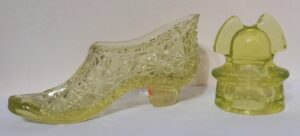
2) Apple Green Glass. This is another color made during the EAPG era, that might be described as a light greenish color with faint bluish tones. Some might call it a light teal, light turquoise or “aqua green”. The exact color shade could vary a bit from one glass company to another. This color was not nearly as common as the more typical clear, medium blue, amber, and canary (Vaseline) pattern glass made in large quantities in the 1880s and 1890s.
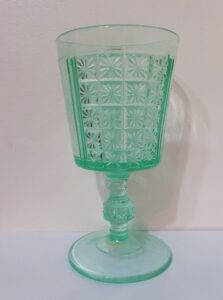
3) Depression Glass (in various shades of light to medium green). A number of glass companies, including Hocking Glass Company, Hazel-Atlas Glass Company, Federal Glass Company , MacBeth-Evans Glass Company and others made green glass that contained uranium during the Great Depression era. (Along with other glass colors popular at the time – the most common DG colors were green, pink, clear and light yellow amber or “topaz”). The color is more decidedly green (not nearly as yellow as the “Vaseline glass” of the EAPG era). This type of glass was made in a multitude of tableware patterns and was most popular from the late 1920s into the very early 1940s.

4) Custard Glass. This is a semi-opaque (translucent) to entirely opaque yellowish glass, ranging from a very light off-white or ivory shade to a light lemon yellow. A lot of custard glass was used for souvenir items, such as toothpick holders and cream pitchers sold at tourist attractions, state and county fairs, etc. McKee Glass Company was a heavy producer of custard glass.
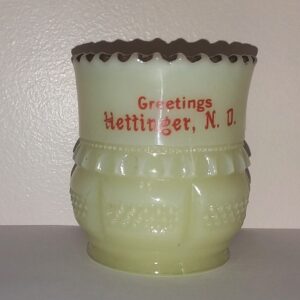
5) Burmese Glass. This somewhat more “upscale” type of glass is similar to Custard glass, but can range in color from a yellow to a peach, salmon or pink, often showing gradations of more than one color on a single piece. Burmese glass pieces often feature a satiny or frosted surface. Vases, pitchers and rose bowls are probably the most commonly produced shapes in Burmese glass. Fenton Art Glass Company was a major producer of this type of glass for many years.
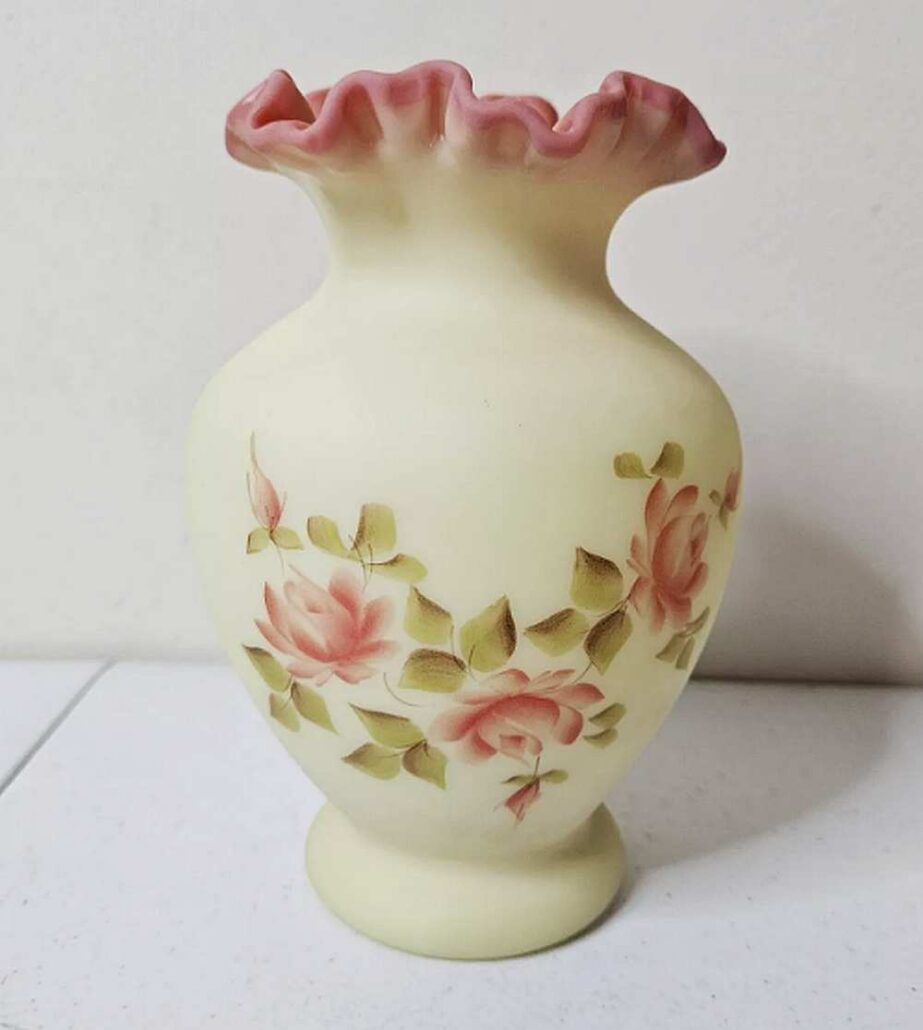
6) Jadite Glass (Opaque / translucent green). NOTE: Some Jadite (Jade-ite or Jadeite) glass may fluoresce under UV light, but (according to several sources online) usually only the older glass produced by McKee Glass Company (introduced in 1930) and Jeannette Glass Company (introduced in 1932) does so.
The majority of Jadite glass seen on the market today does NOT glow. More recently made glass, including Jadeite glass made by Anchor Hocking (usually marked “Fire King” on the base) will not glow since their formula did not include uranium. Other more recent makers of the “contemporary” or “reproduction” Jadeite or Jadite include L.E. Smith Glass Company, Fenton Art Glass Company, and Mosser Glass Company. Most of the glass made by those companies will not fluoresce under a black light. Also, in recent years, large quantities of similar-looking opaque green glassware have been made in Asia, especially China, and exported to the US market.
If you find Jadite glassware in shops, flea markets, antique malls, etc., this may be of some help in distinguishing the newer glass from the older vintage glass of the 1930s. Occasionally, pieces of Jadite “sea glass” or “beach glass” are found by collectors – be sure to pass a pocket black light over any pieces that you find!
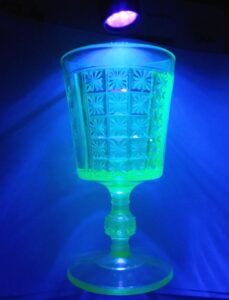
More information can be found here, at the Vaseline Glass Collectors, Inc. website: https://www.vaselineglass.org/what-is-vaseline-glass/
Webpage about Uranium Glass at the Oak Ridge Associated Universities (ORAU) – Museum of Radiation and Radioactivity website: https://orau.org/health-physics-museum/collection/consumer/glass/vaseline-uranium-glass.html
I strongly recommend checking out the following webpage! Shown are the fluorescent effects of shining ultraviolet light on a variety of glass types, not just Uranium glass. For comparison, shown here are the glowing effects seen with Cadmium glass, Selenium glass, Neodymium glass, etc., and red glass coated with Boron Nitride (a mold release agent often sprayed on the inside of a mold) which causes an odd greenish color when the glass is subjected to an ultraviolet light. The effects of Boron Nitride is sometimes confused with that of Cadmium in glassware.
https://www.thebutterflybabe.com/about-uv-glass
Please click here to go to my website GLASS BOTTLE MARKS – HOME PAGE.
Click here to check out my page about Depression Glass.
Webpage with a brief summary on Early American Pattern Glass (EAPG).
Here is the first page of the alphabetical list of glassmaker marks, logos, initials, etc. seen on glassware of all types: Glass Bottle Marks, Page One
ADVERTISEMENT

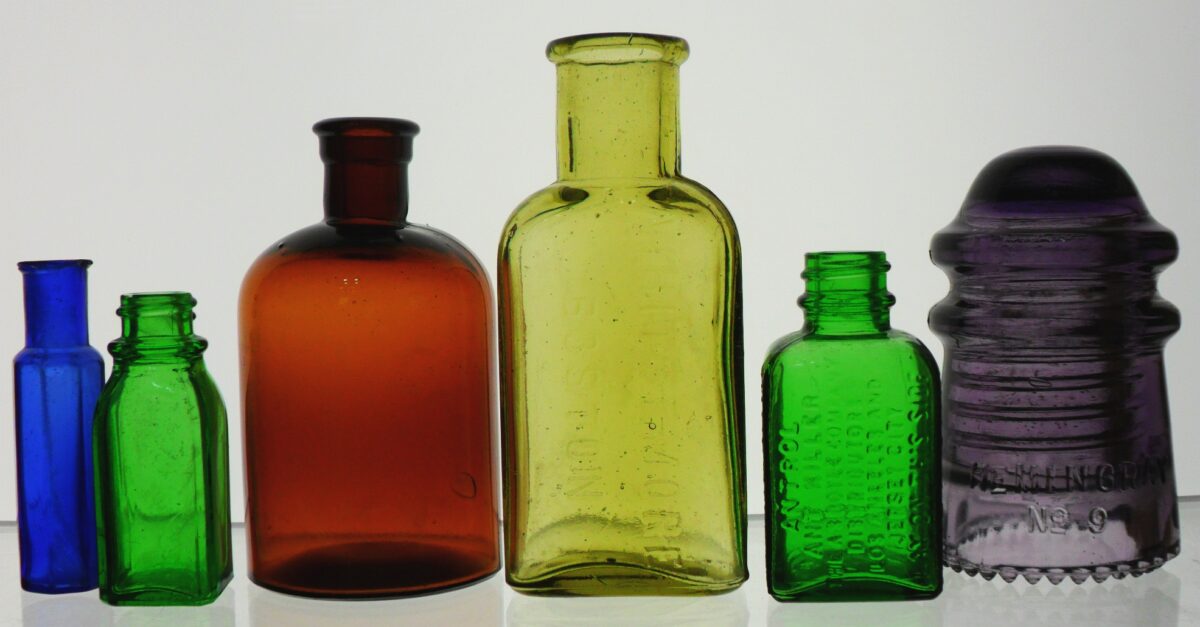
How common is aqua green uranium glass?
Emmett,
I’m not sure I understand your question. Most aquamarine, blue-green, teal, teal aqua, teal green or turquoise colored glass does NOT contain uranium and does not glow under a black light. However sometimes an occasional aqua or teal glass WILL show some reaction from an ultraviolet light source and in that case it would indicate it does contain a small trace of uranium in the glass, most likely introduced as an impurity in “cullet” (broken, used glass) which is a necessary ingredient added to the batch in nearly all glass manufacture.
But, are you asking about the so-called “Apple Green” colored glass shown in my article above? That is a color that sometimes seems to lean slightly toward aqua, and is considered a bit scarce in Early American Pattern Glass tableware.
Thanks for your post,
David